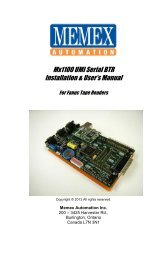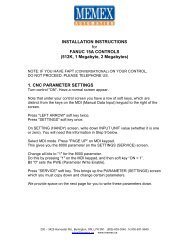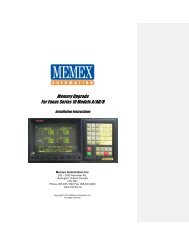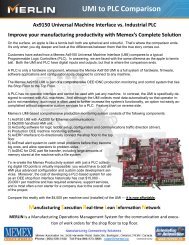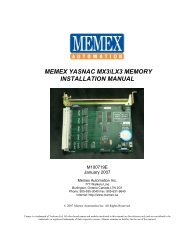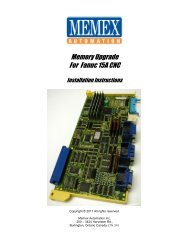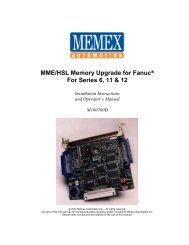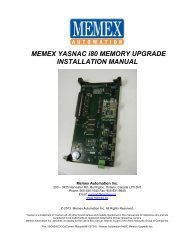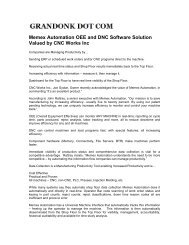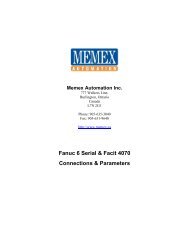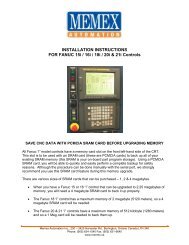Mx1100 Serial BTR for Sanyo Manual - Memex Automation
Mx1100 Serial BTR for Sanyo Manual - Memex Automation
Mx1100 Serial BTR for Sanyo Manual - Memex Automation
Create successful ePaper yourself
Turn your PDF publications into a flip-book with our unique Google optimized e-Paper software.
from <strong>Memex</strong>, is required.) Plug the 26-pin end onto the <strong>BTR</strong>’s JP4 connector, labelled<br />
“PUNCH IN”. The red stripe goes on the side with Pin 1 (see diagram on page 7).<br />
Remove the JP17 jumper (labelled “PUNCH DISABLE”) in the upper right corner of<br />
the <strong>BTR</strong>.<br />
9. Configure the <strong>BTR</strong>.<br />
Set the jumpers on the <strong>BTR</strong> to configure the communications parameters required <strong>for</strong><br />
your DNC system. The option jumpers, listed on page 18, include the following:<br />
A1 and A2 set the Baud rate. Typically 9600 baud (both jumpers ON) is used<br />
unless your cable doesn’t support that rate reliably. The RS232 specification<br />
supports 9600 Baud with a cable length up to 50 feet (15 metres), but it is often<br />
possible to exceed that. It’s important to use cable specifically designed <strong>for</strong> RS232<br />
serial data, 22 AWG, twisted pair, stranded wire (not solid), shielded. Low<br />
capacitance (a rating of 11 to 15 pF per foot) is best. In any case, if you have a long<br />
cable run or are experiencing unreliable data transmission, try lowering the Baud<br />
rate. NOTE: CAT5 Ethernet cable is not suitable <strong>for</strong> use as serial data cable.<br />
A3 OFF adds hardware (RTS/CTS) handshaking. A3 ON is software<br />
(Xon/Xoff) only. Generally it is preferable to use both, which means setting A3<br />
OFF and making sure your cable supports hardware handshaking (see Note 6 on<br />
page 10).<br />
A4 OFF uses the standard Xoff character, $13 Hex. Set A4 ON if your DNC or<br />
terminal software uses $93 Hex <strong>for</strong> Xoff.<br />
A5 OFF uses the standard Xon/Xoff handshaking method (a single Xoff). Setting<br />
A5 ON sends a continuous stream of Xoff back to the computer until the next<br />
Xon. This enables the <strong>BTR</strong> to be used with some terminal programs that were<br />
intended <strong>for</strong> use with a modem, such as Procomm although we highly<br />
recommend the use of proper DNC software.<br />
A6 OFF will echo incoming data back to the PC <strong>for</strong> diagnostic purposes. Set A6<br />
ON <strong>for</strong> normal use.<br />
A7 OFF is ISO data and ON converts incoming data to EIA <strong>for</strong>mat <strong>for</strong> controls<br />
that require EIA data.<br />
A8 overrides the Tape Reader’s selection of <strong>BTR</strong> or Tape mode. If the Tape<br />
Reader wasn’t reconnected to the <strong>BTR</strong>, or if the Tape Reader isn’t intended to be<br />
used often and the <strong>BTR</strong> will usually in Tape mode, set A8 ON. (Remember to<br />
remove it when a tape needs to be read.)




